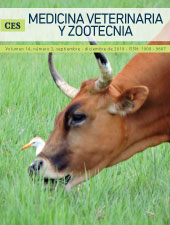High-flow post-surgical oxygen therapy applied through bilateral nasal cannula in two canines undergoing thoracic procedures: a case report
DOI:
https://doi.org/10.21615/cesmvz.14.3.10Abstract
Conventional therapies for oxygen supply used in the veterinary clinic may be inefficient when offering a satisfactory recovery to post-surgical patients under chest surgical procedures with hypoxemic respiratory failure, demanding strategies to improve oxygenation indicators. The present work describes the use of high-flow nasal cannulas in two patients submitted to chest surgeries and under general anesthesia. Patient #1 was submitted to a subphrenic pericardiectomy by thoracoscopy, and patient #2 was submitted to a percutaneous rib fracture reduction by a chest tube. Both patients were recovered with a high-flow oxygen therapy in the post-surgical phase at flow rates of 600 and 1,071 mL/kg/minute, respectively. The oxygen was delivered using a commercial device of active humidification, non-condensable suction with heating system and bilateral nasal cannula, offering an air temperature of 37 ºC, humidity of 98% and inspired fraction of oxygen of 50%. A percutaneous gasometry was performed (dorsal metatarsal artery) after 15 minutes of extubating of the patient, and a second arterial sample was collected 60 minutes after the installation of the high-flow device. An increase in the partial pressure of oxygen (PaO2) was observed without an increase in the partial pressure of carbon dioxide (PaCO2). Additionally, both patients reported satisfactory tolerance to the device. High-flow nasal cannulas should be considered within non-invasive ventilatory support strategies during post-extubating in patients submitted to chest surgeries.
Downloads
References
Crivellenti LZ, Meirelles AE, Rondelli MC, Borin-Crivellenti S, Moraes PC, Andrade AL, Carvalho MB. Bilateral extraluminal ectopic ureters in a Maine Coon cat. Arquivo Brasileiro de Medicina Veterinária e Zootecnia. 2013 jun; 65(3):627-30.
Bartges JW, Callens AJ. Congenital Diseases of the Lower Urinary Tract. Veterinary Clinics of North America: Small Animal Practice. 2015 jul 31; 45(4):703-19.
Crivellenti l. Nefrologia e urologia. Crivellenti, LZ; Borin-Crivellenti, S. Casos de rotina em medicina veterinária de pequenos animais. 2012; 1: 255-304
Davidson AP, Westropp JL. Diagnosis and management of urinary ectopia. Veterinary Clinics of North America: Small Animal Practice. 2014 Mar 31;44(2):343-53.
Morgan M, Forman M. Cystoscopy in dogs and cats. Veterinary Clinics of North America: Small Animal Practice. 2015 jul 31;45(4):665-701.
Having AM, Byron JK. Imaging of the urinary tract. Veterinary Image-Guided Interventions. 2015 Feb 13:263
Mayhew PD, Berent A. Ureteral Ectopia and Urinary Incontinence. Small Animal Soft Tissue Surgery. 2013:538-51.
Volstad NJ, Beck J, Burgess DM. Correction of intramural ureteral ectopia by ureteral transection and neoureterostomy with the distal ureter left in situ. Australian veterinary journal. 2014 Mar 1;92(3):81-4.
Di Mauro FM, Singh A, Reynolds D, Defarges A. Combined Use of Intravesicular Ureteroneocystostomy Techniques to Correct Ureteral Ectopia in a Male Cat. Journal of the American Animal Hospital Association. 2014 Jan;50(1):71-6.
Fossum TW. Small animal surgery textbook. Elsevier Health Sciences; 2013 Jul 19.
Sorgetz FF. Abordagem nutricional na insuficiência renal crônica de cães e gatos: revisão bibliográfica. 2014
Cortadellas O, Fernández-del Palacio MJ. Diagnóstico y tratamiento de la enfermedad renal crónica (ERC) en el perro y el gato. Parte 2: manejo del paciente con ERC. Clínica veterinaria de pequeños animales: revista oficial de AVEPA. 2012;32(4).
Reis JS, Ogoshi RC, de Oliveira FM, Saad B. Nutrologia aplicada à medicina veterinária.
Thomas G. Nyland, John S. Mattoon. Diagnostico ecográfico en pequeños animales. Tercera edición. Multimedica ediciones veterinarias;2016.
Downloads
Published
How to Cite
Issue
Section
License
Copyright (c) 2019 CES Medicina Veterinaria y Zootecnia

This work is licensed under a Creative Commons Attribution-NonCommercial-ShareAlike 4.0 International License.
| Article metrics | |
|---|---|
| Abstract views | |
| Galley vies | |
| PDF Views | |
| HTML views | |
| Other views | |



